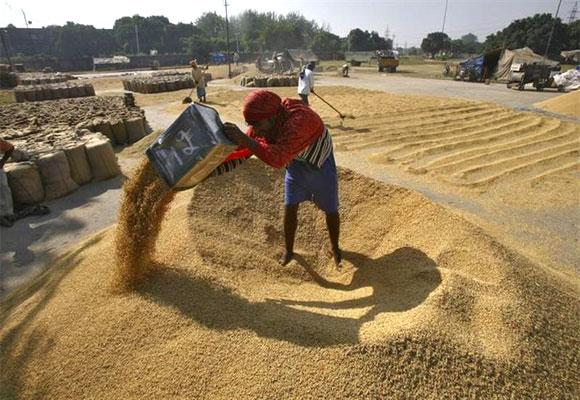 | « Back to article | Print this article |
UPA vs NDA: Who excelled in performance?
A paper demonstrating that the UPA’s economic performance is better than the NDA’s ends up becoming a thinly veiled opinion piece, says Vivek Deheja.
Economists Maitreesh Ghatak, Parikshit Ghosh, and Ashok Kotwal (“Growth in the Time of UPA: Myths and Reality”, Economic & Political Weekly, April 19, 2014) have recently argued that, contrary to popular perception, the United Progressive Alliance (UPA)’s record on economic performance has been rather good, and, pointedly, better than that of the National Democratic Alliance (NDA).
Click NEXT to read more...
UPA vs NDA: Who excelled in performance?
To make their case, they compare aggregate macroeconomic time series during the NDA years as against UPA-I and UPA-II.
Thus, for instance, real gross domestic product (GDP) growth has been higher, on average, during the UPA’s tenure than the NDA’s: averaging 5.9 per cent from 1998-2004, and eight per cent and seven per cent from 2004-2009 and 2009-2013, respectively, giving the UPA an overall average of 7.6 per cent.
Click NEXT to read more...
UPA vs NDA: Who excelled in performance?
They marshal similar data series on other indicators, suggesting that the UPA has performed better than the NDA on most of them.
They concede only that the UPA’s record on inflation has been markedly worse than that of their predecessors.
Click NEXT to read more...
UPA vs NDA: Who excelled in performance?
So far, so good. The trio compile these data from publicly available, easily verifiable sources.
Where questions arise is in their interpretation of the data. Agreeing that the UPA is widely blamed for an economic downturn, an upswing in corruption, and overall poor governance – both from the right and the left – the authors find the “collapse” in support for the UPA to present an “intriguing puzzle”.
Click NEXT to read more...
UPA vs NDA: Who excelled in performance?
This is a peculiar intellectual strategy.
Rather than trying to explain the puzzle of why the UPA is so widely excoriated on economic policy and performance – as they concede, from both right and left – despite raw averages that look good, they proceed instead to create the “deeper paradox” of why voters appear to be dissatisfied with a government that, evidently, has performed well on the economy — thus turning the question they ought to be asking on its head.
Click NEXT to read more..
UPA vs NDA: Who excelled in performance?
Oddly, their initial, but thereafter discarded, hypothesis is one earlier proposed by economists Jagdish Bhagwati and Arvind Panagariya (the latter of whom they explicitly criticise) — the “revolution of rising expectations” on the part of Indian voters.
As Ghatak and co-authors put it: “The high growth of the first eight years raised expectations — what was considered par for the course in 2004 is seen as dismal performance today.”
Click NEXT to read more..
UPA vs NDA: Who excelled in performance?
This, indeed, is a plausible explanation. Yet, in search of their “deeper paradox”, they quickly dismiss this explanation with the non sequitur of an observation that “voters typically vote on living experience rather than the latest statistics”.
Presumably, “living experience” is not constituted, in part, on expectations of economic performance unleashed by rapidly rising prosperity?
Click NEXT to read more..
UPA vs NDA: Who excelled in performance?
The subtext of the authors’ argument appears to be that, thanks to the UPA besting the NDA on a range of economic indicators, it is, somehow, illogical to criticise the UPA’s stewardship of the economy and to suggest that a Narendra Modi-led Bharatiya Janata Party (BJP), for instance, might perform better.
Click NEXT to read more...
UPA vs NDA: Who excelled in performance?
The fundamental methodological weakness here is that the authors merely compare macroeconomic data across time, a statistical exercise at the level of a college term paper, which precludes the possibility of making arguments on the causal relationships among those variables and the policy decisions (or non-decisions) of the respective governments in power when those data were observed.
Click NEXT to read more...
UPA vs NDA: Who excelled in performance?
To put it in simpler terms: it is irrefutable that GDP growth was higher, on average, under the UPA than the NDA.
But this fact, of itself, does not entitle them to infer, therefore, that the UPA were, on average, better economic managers than the NDA on the strength of these growth comparisons.
Click NEXT to read more...
UPA vs NDA: Who excelled in performance?
It is a basic tenet of political economy that, for the most part, economic policy changes affect macroeconomic outcomes with a lag.
This creates the classic dilemma that governments are reluctant to administer bitter economic medicine today because the benefits will accrue once they are out of power.
One could plausibly argue that just such a fate befell both the Rao and Vajpayee governments – the two periods during which we saw a major spurt of economic reform – as neither was able to capitalise politically on the gains, which were diffused over time.
Click NEXT to read more...
UPA vs NDA: Who excelled in performance?
Yet, the argument that reforms under the NDA deserve at least some credit for good economic outcomes under the UPA – a serious and not necessarily partisan claim that ought to be subject to rigorous statistical scrutiny, of a type not undertaken in the article – is caricatured and then dismissed as “little more than political spin from the right”.
Click NEXT to read more...
UPA vs NDA: Who excelled in performance?
It is the conclusion of the article, however, in which the authors tip their hand. A paper that was ostensibly meant to demonstrate that the UPA’s aggregate economic performance was better than the NDA’s, as measured by contemporaneous data – a simple statistical exercise on which there can be no disagreement – ends up turning into a thinly veiled opinion piece.
Click NEXT to read more...
UPA vs NDA: Who excelled in performance?
We are told, sententiously, that “great passions breed extraordinary delusions”, and, by implication, that voters’ evident dissatisfaction with the UPA’s economic performance and the prospect that a Modi-led BJP might possibly do better — reflects a “manufactured reality”, which will “marvel future historians”.
Future historians may also marvel at the extraordinary special pleading by well-respected academic economists in the dying days of the UPA.














